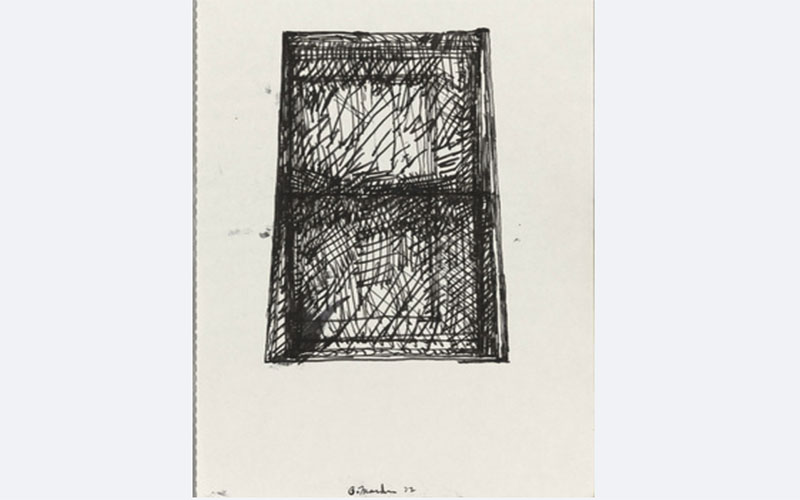
Img: Suicide Notes, Brice Marden (1972)
Children's Minds in the Line of Fire
Adolescent Suicide: Acting out in adolescence
by Silvia Flechner
The adolescent transit is a vulnerable time. Suicidal ideas and attempts can end a young person's life, just as it’s beginning . The thoughts of death are characteristically frequent throughout this period, while the move to action can present in different ways. Sometimes with adolescent suicides, we are left with no satisfactory explanation other than hopelessness and the finding of a certain peace in an irreversible ending.
Attempts or suicide in adolescents express an extreme way of acting, both for the patient and for the analyst. These gestures and attempts impregnate the analyst with unavoidable suffering and impotence.
Dying is part of life. Do we humans know what to do or say in the face of death? It becomes painfully cruel, incomprehensible, and unmanageable when it comes to the death of an adolescent. Hundreds of thousands of young people have not been able to face life, choosing to avoid the dark and overwhelming pain and suffering of a constantly changing psyche and body, where the narcissistic bases are not yet sufficiently secure.
Adolescence is a time of profound psychic change. It is, on the one hand, a time of mourning, involving the loss of childhood and the infantile body, as well as the fall and collapse of idealized infantile parents. It also heralds the appearance of a new, unknown body, perhaps very different from what was expected. Further, it corresponds to the time of the most intense passions, where everything seems to be played out in a single instant: life, love, sex, desire, crises, restlessness, boredom, depression, hatred, aggression, violence, and also death.
Those situations that have impeded the process of subjectivation will be activated, trapping the adolescent in the archaic mother-baby relationship and making it impossible for them to mature. In such a psychic enclosure, they attack their thinking and thereby avoid their inclusion in the peer group and their entry into adulthood. As early traumas are rekindled, the transition into adolescence is weakened.
F. Ladame (1981)[1] highlights the early failures to internalize the original objects, observing in the suicidal adolescent an anxiety of separation and intense persecutory anxiety. This produces a vertiginous ascent of anguish that is increasingly invasive and that ofen spills over to a purely somatic level.
This excessive overflow of internal reality can lead the adolescent to suicidal action thereby reversing the drive movement onto one's person (Chabert 2000) [2] . The movements of hatred directed towards the parental objects is inverted and turned towards the self.
Numerous masked situations can appear, hiding a depressive problem linked to the reactivation of childhood conflicts under the effects of puberty and adolescence. The loss of the child's self, of the parents of childhood, and the child's body may lead to symptoms such as eating disorders, anorexia, bulimia, drug addiction, alcoholism, aggressiveness, and violence.
Current Western societies live in rapid and permanent transformation, with consequent situations of anomie. Cassorla (2019) [3]. In such societies, there are a loss of references, a lack of social cohesion, and confusing identification figures. There is a sense of insecurity and threat, and some anomic suicides occur.
We find ourselves in a frightened and turbulent post-pandemic world. The effect of the pandemic on the mental health of adolescents has been fierce; consultations have multiplied around the world, and mental health systems have failed to adequately address this immense suffering. The socio-economic and political uncertainty is rampant. We are increasingly aware of devastating inequalities and a lack of protection for many. Technology invades our daily lives, generating a perpetual spectacle of distraction that obstructs thought.
What do we notice with adolescents? We see an insufficiency of repression in their transit. Many are in extreme situations of hatred towards themselves, their sexualized bodies, and their parents. Situations of narcissistic overflow generate destructive and violent relationships with oneself or with others.
Symbolic and real death seem to intertwine during adolescence. While symbolic death implies a radical change that dramatizes the conflict typical of this period, between old ties and a new identity, the search for real death, on the contrary, carries out a different project. It is a path without return- the annihilation of the mind.
There are adolescents for whom nothing can be done; others allow us to contact their mental pain, even while telling us that death is their only means to silence the internal enemy that torments them. Death also produces a certain fascination due to its unknowable and unthinkable nature. The suicidal act exposes us to the mystery of life and death, of origin and end.It also sensitizes us to our limits in the face of the incomprehensible.
[1] Ladame, F. 1981 1981 Les tentatives de suicide des adolescents Paris, Masson
[2] Chabert, C (2000) “Le passage á l’acte, une tentative de figuration” Adolescence, Monographie, ISAP, 2000
[3] Cassorla, R. (2019) Suicidio. En busca del objeto idealizado. Revista Brasilera de Psicoanálisis Vol. 53, n.4 pág. 55
 Author:
Author:
Silvia Flechner is an IPA full member. Member of the Uruguayan Psychoanalytic Association. Chair of the Publications Committee .
 Back to Children's Minds in the Line of Fire Blog
Back to Children's Minds in the Line of Fire Blog